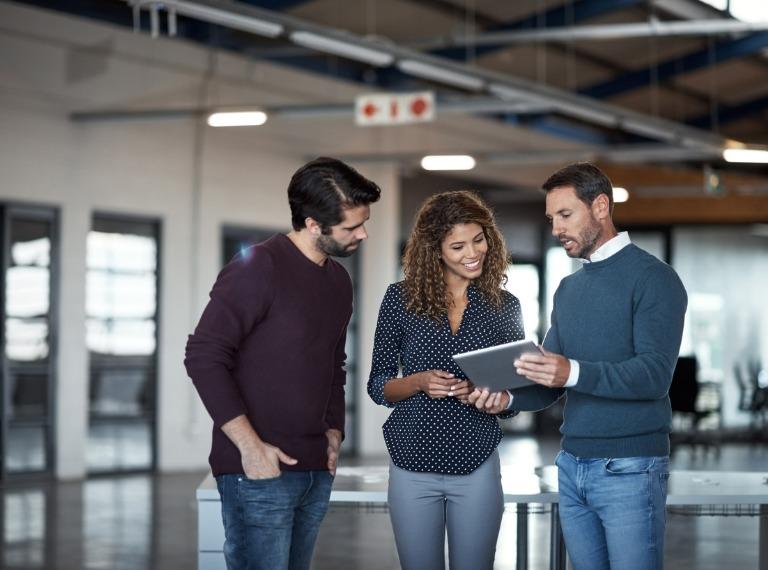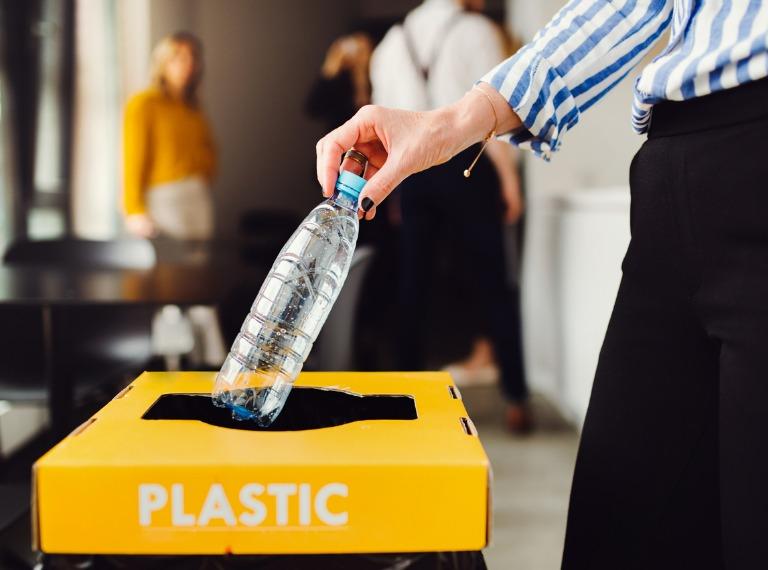The office space is often at the heart of business culture, as it creates collaboration for meetings and group work, enhances relationships across the business and helps with in-house training and development opportunities.
However, increasing numbers of professionals across the UK are finding office workplaces uninspiring and uninviting, with the after-effects of the pandemic causing a shift in work attitudes.
According to a report by interior design firm Claremont Group Interiors, 52% of hybrid workers and 48% of full-time office-based workers surveyed said they feel uninspired by their workplace, while 42% said their office doesn’t make them feel valued.
So, what can businesses do to improve the office space?
Becky Turner, Workplace Psychologist at interior design firm Claremont Group Interiors, explains more in our interview:

Q: What can businesses on a budget do to update their office space to suit the modern workforce?
A: On a budget, it's all about prioritising maximum impact. You’ll probably want to consider phasing some work and so potentially, if your maximum impact is to create a lot more spaces for your colleagues to connect and collaborate with each other, then you might bring in some open collaboration areas, some booths that you can have semi-private conversations in.
But don't lose sight of the bigger picture. Consider a wider programme of works that you might want to do over five years. Maybe create a five-year plan of your real estate and then you can phase it into certain pockets of activity. So, like I say, you're spreading that budget over those five years.
So, design for maximum impact first. Make sure you're communicating with your colleagues about the plan, if you can be as open as possible. Really take them on that journey with you, because then, all these little bits of disruption over the period that you're going to be doing some work, they'll be on board with because they understand the impact that it's going to have on them in the future.
Q: What sort of approach should business leaders take when designing their office space?
A: It's all about engagement. So, engagement with your colleagues at all levels. What do they need?
In this hybrid way of working, which a lot of organisations are taking on board, what's going to be that thing that makes people decide, when they wake up in the morning or they're planning out their diary, ‘am I going to come into the office that day or am I going to work from home?' What's going to make them want to come into the office?
To do that it's not a case of just thinking ‘I know my people, I know what they'll say’, because they might surprise you. It's all about understanding their needs and requirements because they're the ones who're going to be utilising the space, not making assumptions.
Q: How can organisations prioritise energy efficiency for next-generation workplaces?
A: This is a really interesting topic. It's hot on the cards for every organisation: you’ve got standards to meet, there's new and innovative ways to try and meet those standards, and really there's a couple of options here.
It was staggering when we did some independent research and, bearing in mind it was in January so we were going through this cost-of-living crisis and things were a little bit uncertain, we found that 28% of people were coming into the office for the energy and for the heating, which is just absolutely staggering. It's so important; if people are going to come in for the energy, for example, then we need to make sure it's efficient within the workplace as well.
It's largely about designing in some really smart ways to support your energy usage. You might try and look at your mechanical and electrical first and unfortunately, that's usually the biggest chunk from your budget. It’s going into things that are above the ceiling and below the floor that you can't even see, but it's going to make a huge difference to the bill at the end of every month, but also the comfort levels of your colleagues.
Q: How much does an office space impact an employee’s satisfaction and overall productivity level?
A: Employee satisfaction and productivity go hand in hand, they're highly correlated. It’s massive the impact your workplace can have on numerous levels.
Purely functionally, as long as you can come into your space and you can work in the way that you work best, that's going to massively maximise your productivity. If you're an extrovert and you might be doing a bit of admin work, sitting in an area where actually you can get some stimulation, that's going to be important to you and maintain your focus, which for some might seem a little bit backwards, but that's what the research shows.
And then equally, if you've got somebody coming in to do that same role, who might be an introvert or who might be hypersensitive, a little pod, such as the one that I'm in now, is nice and small. You can come, you can plug in, you can control the lighting and the temperature, and it's nice and quiet so you could get your head down and work.
So really providing lots of different spaces where people can feel comfortable getting their work done and work to the best of their ability, that's going to massively improve their satisfaction levels and equally productivity.
Q: How important is personalisation when revamping an office space?
A: It's a really big deal, actually. Historically, if you think about offices and how they were portrayed in movies from the nineties and the early noughties, especially in America, people are in cubicles, and they've all got pictures of their dogs, their family, their kids. People have always enjoyed personalising their spaces; it's their safe space.
So this is a big challenge when you're then opening areas up, and having a slightly more open plan office, particularly now in hybrid working, where not every everyone might have a designated desk. That's where maybe there's this idea that ‘oh no, I'm not going to be able to control my space anymore. I'm not going to be able to personalise it. It's not going to feel like mine.’
It's a change in mindset, about thinking ‘ok, this isn't my space only, it's not my den, it's our space that we all share together and collectively, so how could we all get involved in the design process?’ And this takes me back to one of those first points about engaging with your colleagues. What do you want? What do you need? What's going to make it comfortable for you?
That's the sort of bigger picture of personalising on a grand scale. Everybody's getting a bit of insight and an opportunity to put their thoughts forward within the design. So in a sense it's being created as a collaborative process.
But then alongside that, you can create hackable spaces. These are areas where actually the function might be multifunctional; it's going to really maximise the space that you've got, particularly if you've not too much space. It could be a meeting room that's got walls that could fold back, it could have panels that you can move around. There's a lot of furniture that's on wheels nowadays, so you can move it, you can create the kind of experience that you need. So, on a day-to-day, you can equally personalise it to get exactly what you need from the space.
I'd say an important thing here is that it's great to give somebody a little space that they do own. That might just be a nice sized locker so that people can put their valuable things they might have, especially if they've cycled in, they've got somewhere that they can lock everything up, that's just a little place that somebody owns.
Q: Socialisation is a key part of office life. How can businesses utilise its space to help enhance socialisation and collaboration with colleagues?
A: We’ve almost got two points here where socialisation and connection with your team is so important. We saw over the enforced lockdown period when people were feeling a lot more isolated, mental health went down in general because of this isolation and also the fact that people were unsure of what was going to happen and had lack of control.
The amount of insight you can get from non-verbal communication – by body language for example – is huge. By connecting over teams, you don't quite get that full experience. We've evolved as social creatures to be in front of each other, so I don't think that there's anything that could quite replicate that.
So, what we've been doing quite regularly is creating essentially a social heart to office spaces. Say you’ve got a three-storey office, rather than putting a big social space or a nice kitchen on each floor, you put a few tea points where you can go and get your water, make sure you stay hydrated and maybe a quick brew on each floor, but maybe on the middle one, you'd have a big social space. So that would have your really good coffee machine, as anyone that likes a good coffee will go up to that space and connect with other people that they might not do on a day-to-day basis.
It's the space that you would go to for lunch, and it's the space that you would then go to for events in the evening if you had any social events or ‘lunch & learns’, if that's what your organisation does. Just really social things to get everybody together in one place rather than disperse across the three floors because that's the sure-fire way to create silos if you don't have a central space.
So that's your heart. And that's where everyone's going to come together.
Then you've got the collaboration side as well, and that could be informal. You could use this big social space and that could also be a big collaboration space. It could be an innovation area because it looks and feels a bit different. So you just have to move the furniture around a little bit, creating some tiered seating areas so you could hold big town hall meetings, for example, or present something or get an external organisation to come in and present to you. That way you're really showing that you value your colleagues, you're supporting them through their development, but it's all about providing the platform with your space to enable that.
Looking for your next hire? Speak to one of our expert consultants today.




